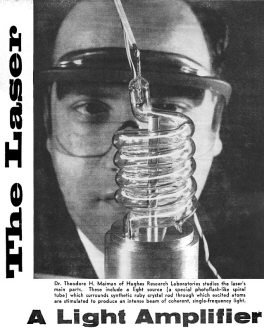The Laser - A Light Amplifier
|
|
Prior to the invention of gas (CO2, HeNe) and chemical (iodine, hydrogen fluoride) lasers in the early to middle 1960s, lasers (light amplification by stimulate emission of radiation) were made using rare earth gems (ruby). Evolution occurred rapidly in power output, wavelength (color), stability, purity, and lasing source type. The concept of lasers were introduced in science fiction, but believe it or not the first recorded instance of the term "LASER" was in a paper written in 1959 by Gordon Gould. Development flowed from the preexisting maser (microwave amplification by stimulate emission of radiation) knowledge. This 1960 news item in Electronics World magazine reported on Dr. Theodore H. Maiman's work at Hughes Research Laboratories. Nowadays lasers are ubiquitous in our lives (DVD players, automotive LIDAR, cat toys) and we have lasers integrated into semiconductor substrates for intra-chip signal communications. The Laser - A Light Amplifier Dr. Theodore H. Maiman of Hughes Research Laboratories studies the laser's main parts. These include a light source (a special photoflash-like spiral tube I which surrounds synthetic ruby crystal rod through which excited atoms are stimulated to produce an intense beam of coherent, single-frequency light. An optical maser which amplifies light by means of stimulating atomic radiation within ruby crystal. Editor's Note: The principles of operation of this new experimental, laboratory device are similar to those employed in the maser except that the laser operates at frequencies that are in the visible light part of the electromagnetic spectrum. instead of the microwave region. In the case of the maser, the ruby crystal is Supercooled to just a few degrees above absolute zero, and a microwave oscillator supplies the pumping signal needed for operation. The laser operates at room temperature and the pumping signal is supplied by a photoflash-like tube high-intensity light source. For complete details on the operation of the maser, which has now progressed to practical use outside of the laboratory, see our lead article on this subject in a forthcoming issue. At a recent press demonstration, Hughes Research Laboratory scientists showed for inspection a new solid-state electronic device that can be used to amplify light. The device, smaller than a water tumbler and containing a rod of synthetic ruby, is an optical maser or "laser" (from Light Amplification by Stimulated Emission of Radiation). Some possible future applications of the light amplifier include its use as a scientific tool for investigating properties of matter and for performing basic experiments of physics. The device will also permit focusing of light into high-intensity beams for space communications and for industrial, chemical, and medical purposes. By communicating on the frequencies of visible light, there would be a large number of channels available that are not currently in use for communications. Most of the applications of the laser stem from the fact that the device is able to generate "coherent" light. The smaller the portion of the electromagnetic spectrum over which any particular source generates energy, the more coherent is the source. Previous sources of light energy, such as incandescent lamps, are "incoherent" sources since they simultaneously generate energy over a relatively large part of the spectrum. R.f. sources, on the other hand, are very coherent. The laser then is used to generate single-frequency light, much like an r.f. carrier, but in the visible-light portion of the spectrum. In operation, a light source, in the form of a powerful flash-tube lamp, irradiates a synthetic ruby crystal which absorbs energy over a broad band of frequencies. This optical energy excites the atoms to a higher energy state from which the energy is re-radiated in a very narrow band of frequencies. The excited atoms are coupled to an optical resonator and stimulated to emit the radiation together, rather than individually and in random, as in ordinary light sources. Small mirrored surfaces at both ends of the long, thin ruby crystal keep the light energy bouncing back and forth long enough for the proper interaction to occur. Small pinhole openings in the mirrored surfaces permit entry of the light that is to be amplified and emission of the amplified light at the other end. Because of the coherence of the generated light, perfectly parallel, needle-sharp beams could be generated less than one-hundredth of a degree wide. What is more, this beam would not spread or scatter as does ordinary light. As a result of such concentration, extreme brightness and intense local heat would be produced.
Posted August 18, 2021 |
|

